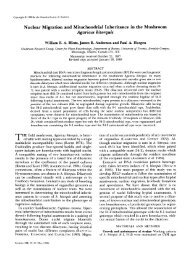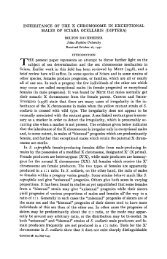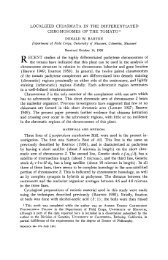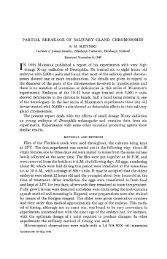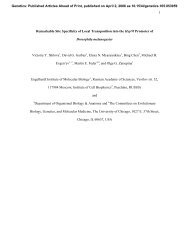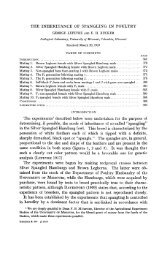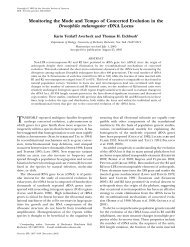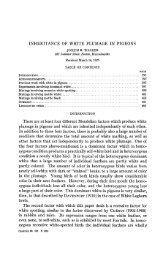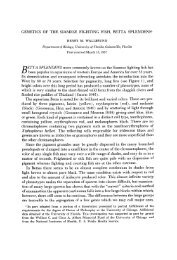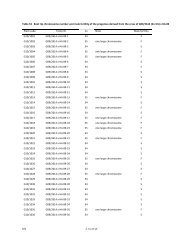abstracts of papers presented at the 1962 meetings - Genetics
abstracts of papers presented at the 1962 meetings - Genetics
abstracts of papers presented at the 1962 meetings - Genetics
You also want an ePaper? Increase the reach of your titles
YUMPU automatically turns print PDFs into web optimized ePapers that Google loves.
ABSTRACTS 995<br />
possibly third) mitotic wave also appears, starting <strong>at</strong> about 28 hours. Thus, even in <strong>the</strong> slowly<br />
prolifer<strong>at</strong>ing forestomach, cells which have divided once have a certain tendency to divide again<br />
within a very short time. (Research carried out <strong>at</strong> Brookhaven N<strong>at</strong>ional Labor<strong>at</strong>ory under <strong>the</strong><br />
auspices <strong>of</strong> <strong>the</strong> U.S. Atomic Energy Commission and supported by U.S. Public Health Service<br />
Fellowship No. CF-14, 272 from <strong>the</strong> N.I.H.)<br />
WUNDERLICH, JOHN R., and LEONARD A. HERZENBERG, Department <strong>of</strong> <strong>Genetics</strong>, Stanford<br />
University School <strong>of</strong> Medicine, Palo Alto, California: A second gamma globulin isoantigen (allotype)<br />
in <strong>the</strong> mouse.-A gamma globulin isoantigen was reported to be present in serum from<br />
<strong>the</strong> inbred mouse strains “BALB/c,” C3H/He and “Champagne-Glaxo” but absent from <strong>the</strong><br />
serum <strong>of</strong> “C57BL” (KELUS, A., and J. K. MOOR-JANKOWSKI, N<strong>at</strong>ure 191:1405, 1961). We have<br />
found a second gamma globulin isoantigen demonstrable by immunoelectrophoresis on cellulose<br />
acet<strong>at</strong>e. Antiserum from BALB/c animals immunized with <strong>the</strong> globulin fraction <strong>of</strong> C57BL/6J<br />
serum forms a single precipitin line in <strong>the</strong> gamma globulin region <strong>of</strong> <strong>the</strong> electrophoregram with<br />
serum from C57BL/6J and also from C57BL/Ka, C57BWlO.l and B10.D2. It does not react detectably<br />
with serum from BALB/c, or A/J, C3H/Sn, DBA/2J and CBA/J. The antigen is<br />
present in all tested F, progeny from <strong>the</strong> m<strong>at</strong>ing <strong>of</strong> a positive by neg<strong>at</strong>ive strain. Appropri<strong>at</strong>e<br />
backcrosses have been set up.-A sensitive test has shown this isoantigen to be associ<strong>at</strong>ed with<br />
antibody activity. When a C57BL/Ka antiserum to <strong>the</strong> collphage T2 is used as antigen in reaction<br />
with <strong>the</strong> BALB/c antiglobulin serum, a specific loss <strong>of</strong> <strong>the</strong> phage-neutralizing activity<br />
results, indic<strong>at</strong>ing th<strong>at</strong> <strong>the</strong> isoantigen is on antibody molecules.<br />
YAMADA, YUKIO, and A. E. BELL, Purdue University, Lafayette, Indiana: Selection for 13th<br />
day larva weight in Tribolium under two nutritional 1euels.-Selection for large and small<br />
13th-day larva weight in Tribolium castaneum has been investig<strong>at</strong>ed in order to evalu<strong>at</strong>e <strong>the</strong><br />
effectiveness <strong>of</strong> various selection methods and <strong>the</strong> importance <strong>of</strong> genotype by environment interaction<br />
under two different nutritional levels. In addition to an unselected control popul<strong>at</strong>ion,<br />
<strong>the</strong>re were eight experimental popul<strong>at</strong>ions as follows: GL = selected large based on sib record<br />
under <strong>the</strong> good level each gener<strong>at</strong>ion; PL = selected large under poor level each gener<strong>at</strong>ion;<br />
-<br />
GPL = selected large on average performance under both levels; GPL = selected large under<br />
good and poor levels in altern<strong>at</strong>ing gener<strong>at</strong>ions; and similar four popul<strong>at</strong>ions for small direction.<br />
Each popul<strong>at</strong>ion was reproduced by 4.0 single pair m<strong>at</strong>ings each gener<strong>at</strong>ion under standard<br />
whe<strong>at</strong> medium. Selection was made on <strong>the</strong> basis <strong>of</strong> full sibs reared ei<strong>the</strong>r under good, poor, or<br />
average <strong>of</strong> both levels, depending on <strong>the</strong> selection methods. After choosing <strong>the</strong> best eight<br />
families out <strong>of</strong> 40, five males and five females from each selected family were taken from <strong>the</strong><br />
standard medium. They were m<strong>at</strong>ed <strong>at</strong> random with <strong>the</strong> restriction th<strong>at</strong> full-sib m<strong>at</strong>ings are<br />
avoided. Therefore, each family has full-sib records under both environments, and any specific<br />
environmental carry-over effect through parents is completely removed by <strong>the</strong> use <strong>of</strong> sib selection<br />
from <strong>the</strong> standard medium.-Heritability <strong>of</strong> <strong>the</strong> selected trait in <strong>the</strong> base popul<strong>at</strong>ion both<br />
under good and poor levels <strong>of</strong> nutrition was estim<strong>at</strong>ed to be roughly 20-25% and <strong>the</strong> genetic correl<strong>at</strong>ion<br />
was about 0.50 (HARDIN <strong>1962</strong>).-Effectiveness <strong>of</strong> <strong>the</strong> selection methods and role <strong>of</strong> interaction<br />
will be discussed. (Supported by a grant from <strong>the</strong> N<strong>at</strong>ional Science Found<strong>at</strong>ion.)<br />
YANAGISAWA, KEIKO, (Introduced by FRANCIS J. RYAN), Columbia University, New York, New<br />
York: The simultaneous accumul<strong>at</strong>ion <strong>of</strong> RNA and <strong>of</strong> a repressor <strong>of</strong> ,&galactosidase syn<strong>the</strong>sis.-<br />
The methionine-requiring mutant, 58-161, <strong>of</strong> E. coli, continues to syn<strong>the</strong>size RNA even after<br />
being deprived <strong>of</strong> all exogenous methionine. The effect <strong>of</strong> methionine starv<strong>at</strong>ion on <strong>the</strong> form<strong>at</strong>ion<br />
<strong>of</strong> P-galactosidase was studied using this strain. After methionine starv<strong>at</strong>ion, a long lag was<br />
observed in /3-galactosidase form<strong>at</strong>ion, although total protein started to increase immedi<strong>at</strong>ely<br />
upon restor<strong>at</strong>ion <strong>of</strong> methionine. This delay was not observed in E. coli 15 hismet-, in which<br />
RNA is not syn<strong>the</strong>sized during methionine starv<strong>at</strong>ion. If <strong>the</strong> former strain was deprived <strong>of</strong> a<br />
carbon source along with methionine, RNA did not increase during starv<strong>at</strong>ion and no delay was





